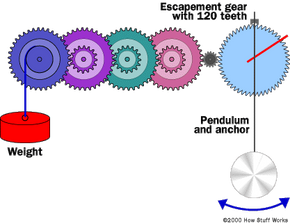Gearing Up!
The problem of having to rewind every 20 minutes is easy to solve. As discussed in How Gear Ratios Work, you can create a high-ratio gear train that causes the drum to make perhaps one turn every six to 12 hours. This would give you a clock that you only had to rewind once a week or so. The gear ratio between the weight drum and the escapement gear might be something like 500:1, as shown in the diagram below:
In this diagram the escapement gear has 120 teeth, the pendulum has a period of half a second and the second hand is connected directly to the escapement gear. Each gear in the weight's gear train has an 8:1 ratio, so the full train's ratio is 492:1.
Advertisement
You can see that if you let the escapement gear itself drive another gear train with a ratio of 60:1, then you can attach the minute hand to the last gear in that train. A final train with a ratio of 12:1 would handle the hour hand. Presto! You have a clock.
Now this clock is nice, but it has two problems:
- The hour, minute and second hands are on different axes. That problem is generally solved by using tubular shafts on the gears and then arranging the gear trains so that the gears driving the hour, minute and second hands share the same axis. The tubular gear shafts are aligned one inside the other. Look closely at any clock face and you can see this arrangement.
- Because all of these gears are connected directly together, there is no easy way to rewind or set the clock. That is often handled by having a gear that can be slipped out of the train. When you pull on the stem of a wristwatch to set the watch, that is essentially what you are doing. In the figure above, you might imagine temporarily removing the small black gear to either wind or set the clock.
You can see that, even though all the gears in a clock make it look complicated, what a pendulum clock is doing is really pretty simple. There are five basic parts:
- Weight or spring - This provides the energy to turn the hands of the clock.
- Weight gear train - A high-ratio gear train gears the weight drum way up so that you don't have to rewind the clock very often.
- Escapement - Made up of the pendulum, the anchor and the escapement gear, the escapement precisely regulates the speed at which the weight's energy is released.
- Hand gear train - The train gears things down so the minute and hour hands turn at the right rates.
- Setting mechanism - This somehow disengages, slips or ratchets the gear train so the clock can be rewound and set.
Once you understand these pieces, clocks are a piece of cake!
